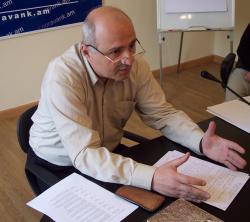NORAVANK LECTURING HARUTYUN MARUTYAN: “THE FACE OF POVERTY IN ARMENIA: THE MAIN TENDENCIES”
 On March 28, 2008 within the framework of the scheduled series of readings “Armenia and Armenians in global developments: recent trends and challenges” in “Noravank” Foundation was held a lecture on “the face of poverty in Armenia: the main tendencies.” The reading was lectured by the RA NAS leading specialist of the institute of Archeology and Ethnography, the head of the coordination-information center of “Noravank” Foundation and the Doctor of Historical Science Harutyun Marutyan.
On March 28, 2008 within the framework of the scheduled series of readings “Armenia and Armenians in global developments: recent trends and challenges” in “Noravank” Foundation was held a lecture on “the face of poverty in Armenia: the main tendencies.” The reading was lectured by the RA NAS leading specialist of the institute of Archeology and Ethnography, the head of the coordination-information center of “Noravank” Foundation and the Doctor of Historical Science Harutyun Marutyan.
The lecturer mentioned that the report is based on qualitative researches and while representing the present situation of poverty he would not turn to figures. The lecturing was based on the books on “Stories about poverty” brought out by Harutyun Marutyan and his colleagues; the second one has been issued recently. The book includes episodes and detailed interviews with the poor as well as professional analysis. In the second book the ethnographers again “visited” the 30-33 families they had detailed interviews with in 1994-2000 and tried to find out the dynamic of changes.
The analysis of the materials gathered within 1994-2005 have come to prove that of course there have been some changes in the social condition of the poor families, however, the matter is the essence of the changes and if they are influenced by the rise reported in the economy of Armenia and the direction they are leading to.
The reporter thoroughly turned to those changes stressing up work and self-occupation, intra-family and congener, male and female relations, education, housing conditions, food, clothing, public health, and debt paying off up-to-date schemes. H. Marutyan spoke about social stratification of the Armenian society, the difficulties of shaping the middle class and the situation in the field of using the land. In particular he mentioned that at present one can witness the process of agricultural land extension, which is, probably, justified economically, but in reality results serf laboring of peasant households and doesn’t reduce emigration. Comparing his and his colleagues field-ethnographic materials H. Marutyan came to the conclusion that yes, there are changes, but not in the direction of furthering social polarization and reducing poverty.
The lecture was followed by an active discussion accompanied by a number of questions and answers including the culture of poverty and other problems.


